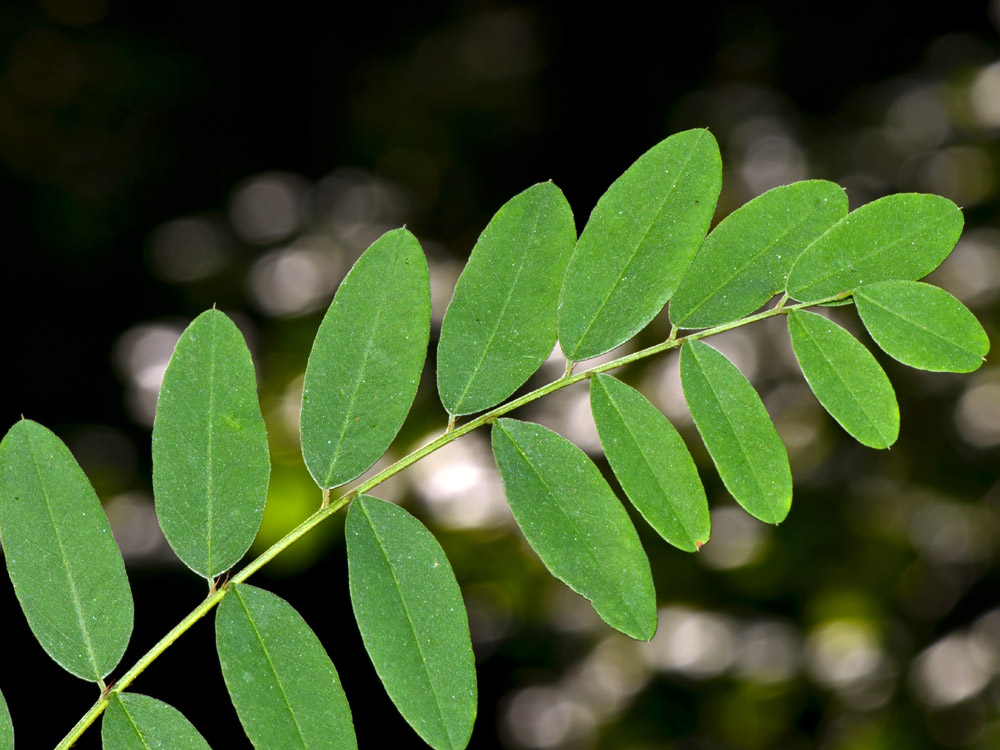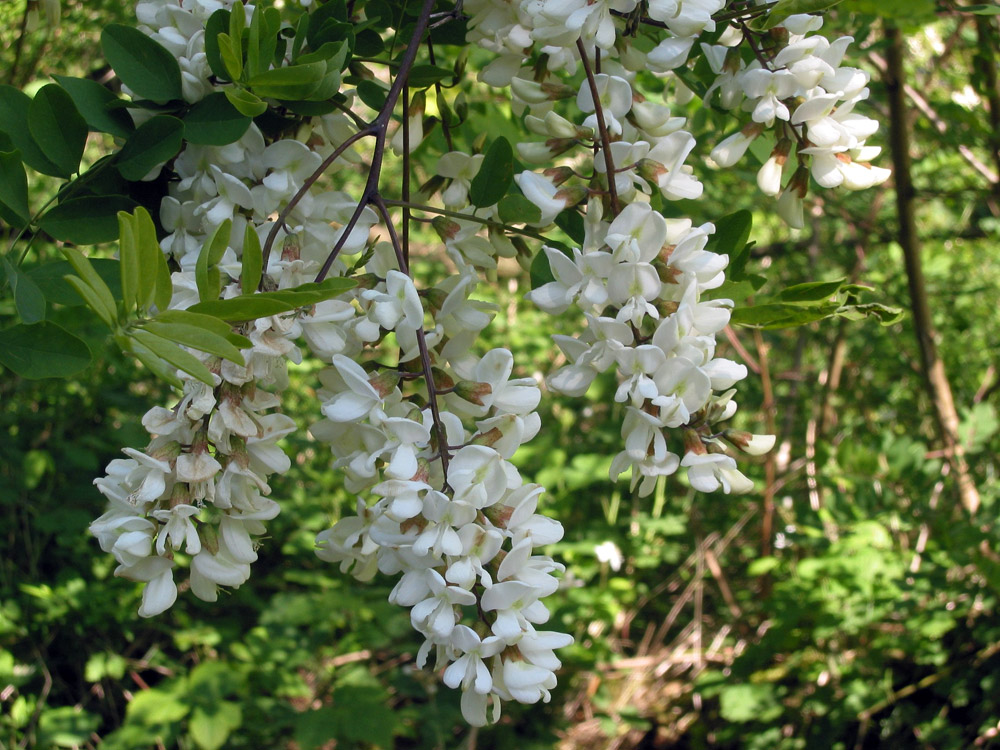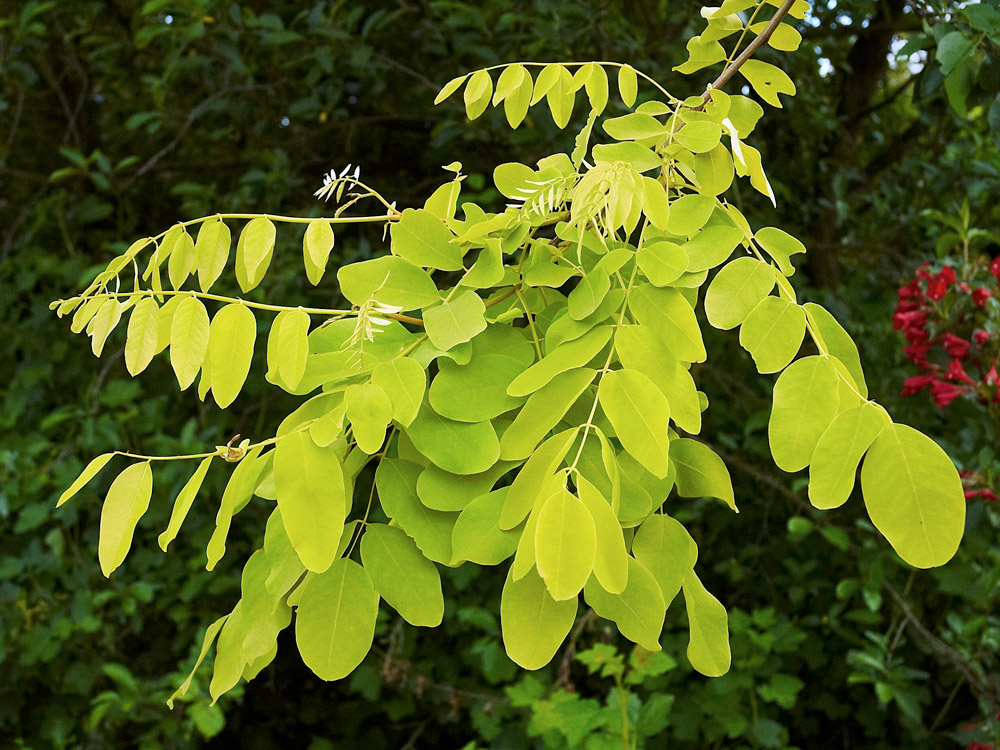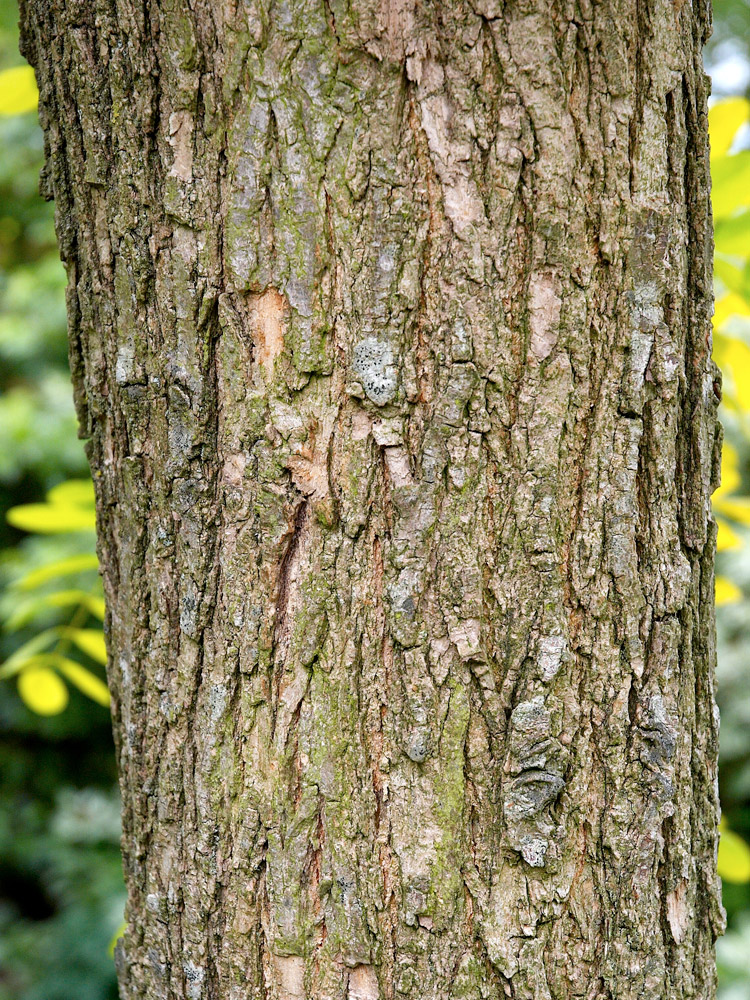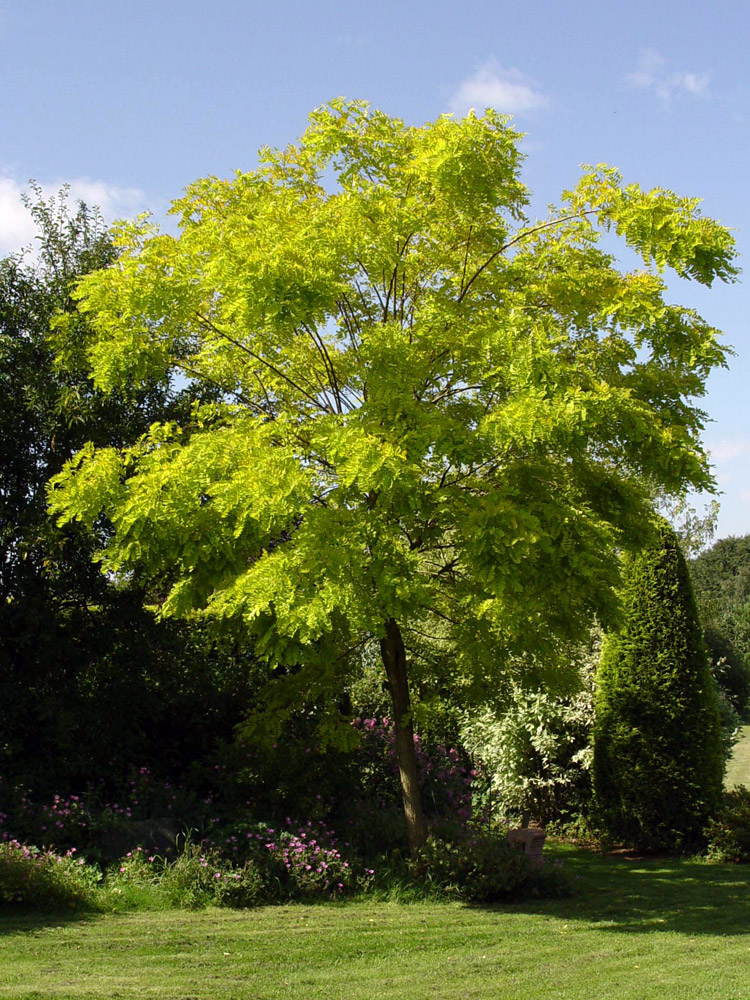Garden Plants, How
and where to grow them
Trees
Robinia pseudoacacia "Frisia"
False Acacia - Tree
One of the most popular ornamental trees. A light and airy canopy allows light to filter through so it can be grown in places where other trees might cast too dense a shadow
Buy Robinia pseudoacacia Frisia
 There are a variety available, but the most popular
and best is the grafted cultivar "Frisia" which has
golden yellow foliage that appears all the brighter with the
sun shining through it.
There are a variety available, but the most popular
and best is the grafted cultivar "Frisia" which has
golden yellow foliage that appears all the brighter with the
sun shining through it.
Unlike most yellow leaved plants, rather than getting darker and greener as the season goes on, this one gets yellower and brighter right up to the autumn. The top growth is grafted as a young bud onto the young root stock and so like other grafted plants such as many roses and fruit trees it may produce suckers from low down that will take over if allowed.
Also commonly offered is the non-grafted rootstock species Robinia pseudoacacia, a less refined tree by comparison and inferior for most garden purposes. It produces fragrant white flowers in spring and midsummer however, it grows larger than Frisia and produces more suckers. The leaves of the species form are dark green in colour. It is faster growing and more aggressive than the more benign Frisia.
Height and spread Frisia: 50 ft (15m) x 25ft (8m)
Make sure you purchase a potted and rooted tree. They are sometimes offered as bare rooted trees in the winter months which are larger and cheaper. These can be good value if you can be sure they are replanted almost immediately, but will not survive very long at all if not, certainly no where as long as other kinds of tree commonly sold bare rooted. If there is any doubt at all as to how long they have been out of the ground, then decline to purchase. Before I realised this only about 3 out of every 5 bare-rooted Robinias I bought would ever grow again.
Uses - Ornamental specimen tree
Pruning: Mid to late summer.
Established trees are best left unpruned or keep pruning to an absolute minimum. Large cuts rarely heal well and are prone to rot, the tree may respond with a profusion of vigorous, but structurally weak vertical "water shoots" that can become dangerous if allowed to grow large. Renovation is not really possible, best to fell a neglected or misshapen tree and replace it. If the tree is the species, then it may be replaced by one of the suckers that grow, if it was a Frisia or other cultivar, then the suckers will be of the species and not like the original ornamental cultivar, remove all these suckers as they appear.
Questions about Robinia pseudoacacia Frisia
Q. I have a Robinia Frisia, which has grown very big in the ten years since I planted it (I have had it lopped three times). However, for several years now it continually drops it leaves throughout the whole Summer - it is dropping very heavily already this year. Is this normal - or is there anything I can do?
A. That sounds like a very unhappy tree. Robinias shouldn't drop leaves at all until the autumn. Are there any signs of damage, disease or pest attack? Is it stressed in any way because of its position?
My guess is that it's a combination of things exacerbated or initiated by being lopped so often - Robinias don't like being pruned at all, 3 times in 10 years is a heck of a lot for that tree.
What can you do about it? I'd be tempted to buy another
and plant it somewhere that it can have enough space as to not
need lopping.
Q. I am considering buying a Robinia Frisia and they all seem to be grafted - is this ok or should you by a root tree? What are the pros and cons?
A. Plants are grafted to get the best of a good strong rootstock and quality top growth. Non-grafted trees will either have poor roots or be less attractive (but usually strong growing) above the ground. Go for a grafted tree, particularly a Robinia - non-grafted ones just don't have the same colour.
Q. addendum.
Thanks Paul for that info
- very helpful. In fact the Robinia Frisia I have been looking
at is apparently 'budded' not 'grafted' - I
don't really know what the difference is - could you explain?
Research I have been doing has thrown up an interesting question about the rootstock Robinia Frisias are grafted to. Apparently the rootstock is R. Pseudoacacia which is a vigorous green-leaved tree with thorns. I have always understood this was the name given to the Golden leaved tree itself. If this is the case what is the name of the Golden leaved tree that is grafted to this rootstock?
I also understand they are very prone to suckering - if these were to grow it would be the green leaved variety - these are best cut off at the root if occur.
A. addendum.
Robinia pseudoacacia is
the species, Robinia pseudoacacia "Frisia" is a variety
of that species (horticulturalists are not always very precise
about taxonomy). Budding is a type of grafting where a single
growing bud rather than twig or larger piece is grafted - different
techniques suit different plants. This technique is used to
combine a plant with attractive top-growth but a poor root system
with a plant with a strong root system but not very attractive
or useful top-growth.
I've never had any problems with this tree (Frisia as
opposed to the species) suckering, as you say cut them off at
the root if any suckers emerge. They will however sucker if
cut down as the roots will try to keep growing and produce some
leaves to do so.
Q. I have a 10-year old Robinia (pseudoacacia) which was pruned hard by professionals earlier this year as it had grown more than we wanted and was overhanging a neighbours garden and touching their upstairs window. We enjoy its lovely yellow leaves and don't want it too small (or too large).
Now that more shoots have grown after the pruning, we would
like to keep it to a manageable size and wish to know which
is the correct month to lop off the tops of these shoots and
shape the tree, please?
I believe that we may have to prune
every year to keep it from growing to full height of about 50
feet. Am I right?
A. Your Robinia will probably react to the pruning with quite vigorous vertical growth from around the cuts. The trick is to stop this new growth from developing, so rub out the buds or cut the shoots if that bit older as soon as you can. Mid to late summer is best for pruning Robinias, but new growths can be removed as soon as you see them.
You need to stop the tree from developing any new substantial leaders which it may do, these will compete with the original leader and may result in a misshapen and structurally weak tree. Narrow crotch angles are weak in these trees.
Also, it may respond to pruning by developing suckers - shoots that grow upwards from the roots a little distance from the main trunk. Again these should be removed as soon as possible or they will compete.
Robinias don't really respond well to pruning I'm
afraid, their natural vigour results in them trying to keep
growing upwards and end up being an odd shape. I think if I
were you, and you have the room, plant another some distance
away from the house and by the time the new one has established
itself, the original may have reached the point where sadly
the felling axe may be needed. You could replace the current
tree with a yellow-leaved shrub instead.
Q. My elderly father having cut down his Robinia Frisia yellow leafed tree has found suckers coming up all over the lawn and up to the house. He is very worried as to if these will damage the foundations of the house or get into the drains and thinking of having 10 inches of topsoil removed to try and eliminate these suckers spreading. What is the solution to these spreading thorny suckers (once tree has been removed) and should these trees come with a government health warning. They are very pretty and really enliven a dull northern hemisphere garden. From Jane in Jersey U.K.
A. The suckers are coming from existing roots, any damage would have already been done, suckers just represent the tree trying to survive a disaster. Cut them (mow them if they aren't too strong) as they appear and the resources will eventually be used up and the roots die. Should they have a health warning? I don't think so.
The suckers by the way won't be "Frisia" but
the rootstock tree, Robinia pseudoacacia, the "Frisia"
cultivar will have been grafted onto the species rootstock,
so you can't use this as a quick way of getting dozens of
new Frisia trees, they'll all be plain old R. pseudoacacia.
Q. What do I have to do to get my Robinia pseudoacacia Frisia to flower?
A. You can't, they don't - well they do very rarely and it's down to the individual tree. The species tree flowers - Robinia pseudoacacia - but Frisia is a sport and the golden yellow foliage is the trade off for a lack of flowers.
Q. I have been looking at Robinia very informative, but you do not say when leaves should start in Spring. We have one that has not sprouted yet (April 2nd) and we are very worried about it.
A. Robinias do a very good line in dead-looking twigs and they're often one of the last trees to shoot in the spring, there's plenty of native trees that aren't yet shooting, could be up to another month. If it still hasn't done so by mid May then worrying won't help but would be appropriate.
Q. Robinia "Frisia" - I am trying to find out what the root structure is on this tree. I have one planted within 4 feet of a neighbours house and they are concerned about the footings. Its a mature tree ( some 25ft high) and I want to avoid removing it if the roots don't present a problem. Have contacted several local garden centres without success. Any advise appreciated.
A. The root structure is almost irrelevant. A leafy 25 foot anything tree, just 4 feet from a house is far too close for comfort. Its not physical damage by the roots penetrating the foundations that is the problem so much as how the leaves suck up water and dry out the soil so causing shrinkage and swelling over the period of the year that can crack brickwork.
Will it actually do this? Who knows? There are far too many variables, but would I suggest that you leave it in place with an assurance that it is ok? - no way. Would I plant a tree myself that will grow to such an height so close to a house? - no way.
Robinia's are members of the Leguminosae and so will
most likely have a tap-root as characteristic of the family.
Frisia can grow to 50ft and doesn't take kindly to pruning.
Q. I received a Robinia Pseudoacacia 'Frisia' (potted, but I believe it was a bare root just bunged in a pot before shipping) last spring. After a very shaky start - the garden first flooded then we had 2 months with no rain at all - it's doing well. However, the nursery, before delivery, cut off the leader to fit it in the delivery box. The tree doesn't seem to have responded with a new leader - just side shoots. Should I train the topmost side branch shoot up into a leader?
A. The answer is yes. Young Robinias aren't particularly hardy though and some shoots may not last the winter, so I'd leave what it has at the moment until you start to see growth next spring and remove the extra shoots then.
Q. We removed a Robinia last year and of course the shoots from the old root are emerging all over the backyard. I have been treating these with blackberry killer and kero, is it true that the shoots should be treated within 30 seconds of splicing the sucker and how many years will this have to be done until they don't re appear?
A. I'd be less inclined to treat with any kind of weedkiller, more just to mow them down when they get big enough for the blades to reach them. It causes less harm to surrounding plants and soil this way. The secret is to make sure they don't get big enough to feed the reserves again. Growing to food-making size uses energy, allowing them to start to make food again fills the reserves.
The 30 second rule is news to me. If you really want to get
to them, follow a shoot and dig down to a big underground root,
use a big - 12mm drill bit, make a hole and fill with your blackberry
killer - dot this treatment around and you'll have better
success.
Q. I would like to plant a false acacia tree in my front garden, one metre from a four foot stone wall and the pathway on the roadside. It's south facing, sheltered by the wall as the ground dips, and I want it to add height and interest to a boring front garden (but not too much height.) Is this he right tree? Worried it may grow too tall and have read that pruning isn't good for it.
A. Is 30ft too tall? If it is, then go for something else as this is what it will reach at least. If you want a smaller tree I'd go for a Victoria plum as I love them and they give you spring blossom and autumn colour too.
Q. I have just bought 2 Robinias, as recommended by a garden center (who was aware of my garden dimensions). I have planted them (wrongly thinking they are miniatures) 4' apart, as centrepiece to a flowerbed measuring 1.2m x 4m. My garden is 3.5m x 10m and they are 6m away from the house. I have now read your information and I'm worried they're going to cause me a whole lot of trouble. I am now thinking of digging them up. What do you think?
A. This page is about Robinia pseudoacacia, as this is the commonest Robinia, there are other species in the Robinia genus, some of which are much smaller and suitable for your site, yours may well be one of these smaller varieties.
Q. For the past several months I've been trying to find tree farms or garden centres in my area that sell Robinia pseudoacacia "Frisia" trees, with no luck...do you sell these plants and would it be possible to purchase one from Canada?
A. Plants don't usually ship overseas as transport for individuals or small numbers would be prohibitively expensive and they probably wouldn't survive anyway.
Robinia Frisia are hardy in zones 4-8, though here in England, they need to be about 6 feet tall to survive most winters outdoors, I'd guess that in Canada, they are less likely to survive without some protection at least in their early years, the species is more hardy.
Buy Robinia pseudoacacia Frisia
Photo credits: (numbering left to right top to bottom) 1-copyright User Colin Wikimedia Commons Creative Commons 3.0 Share Alike licence / 2-Ninjatacoshell - Creative Commons Attribution 3.0 Unported license. / 3-Norbert Nagel Morfelden Walldorf Germany - Creative Commons Attribution 3.0 Unported license. / 4-Rasbak - Creative Commons Attribution 3.0 Unported license. / 5-Robinia pseudoacacia B Public domain / 6-Robinia pseudoacacia C Public domain / 7-Robinia pseudoacacia Public domain
Copyright 2000 - present. All Rights Reserved | Privacy Policy Statement


